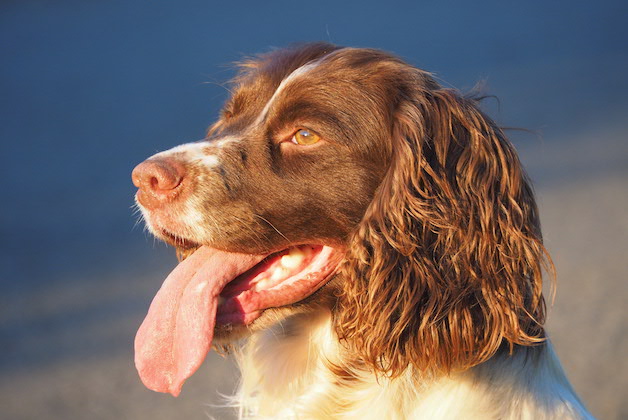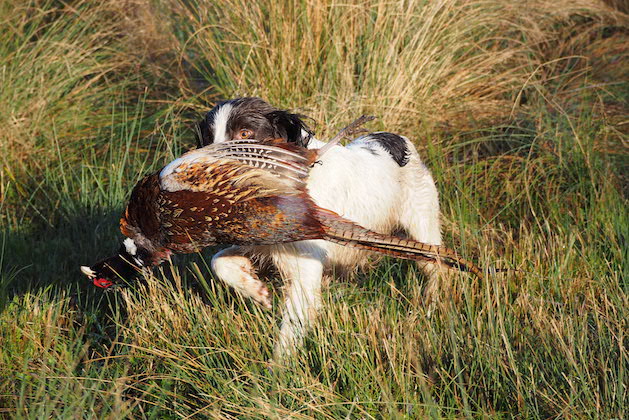13 reasons why cocker spaniels and springer spaniels are different
Both springer and cocker spaniels are capable of doing a useful day’s work out in the field. Both are biddable.…
Win CENS ProFlex DX5 earplugs worth £1,149 – enter here
 Julia’s handsome but wilful springers Odin
Julia’s handsome but wilful springers Odin
Throughout the 20th century English springer spaniels were the most popular shooting dog in Britain. Whether it remains so today is debatable. In recent years I’ve been on a number of shoots where there wasn’t a springer to be seen, something that would have been unthinkable 20 or 30 years ago.
Finding hard evidence to prove the decline is difficult, but the Kennel Club’s annual registration figures record a steady decrease. In 2010, 13,988 English springer puppies were registered with the club, but in 2016 the figure dropped below the 10,000 mark to 9,827. In 2018 there was a slight recovery with 10,152 registrations, but that’s hardly of statistical significance.
Kennel Club registration figures can be misleading, as they fail to differentiate between show and working strains, which in the case of the springer is important, as the two are virtually different breeds. However, show springers are relative rarities, so I think we can safely assume that the majority of springer puppies registered are of working stock. Incidentally, the consistent popularity of the cocker during the past decade is remarkable. In 2010 the Kennel Club registered 23,744 puppies, last year it was 23,927. My guess is that the majority are show-bred pets, but workers must account for a sizeable proportion.
Kennel Club figures don’t tell the whole story for another reason: there are a lot of pure-bred litters of springers bred every year from unregistered parents, so the puppies can’t be registered either.
Again, there are no hard facts to back this up, but I suspect that there are many more unregistered springers working on shoots than there are cockers or Labradors. I’ve owned unregistered springers for more than 35 years; as I don’t trial or show my dogs there’s no reason for them to be registered.

The changing face of shooting has a big impact on our gundog choices
It’s easy to find a number of reasons for the decline in the springer’s popularity. The most significant has been the growing popularity of the working cocker. Fifty years ago cockers were in what seemed like terminal decline and they were relatively rare on shoots for a sound reason: they weren’t really very good. The cocker’s revival is largely due to a small number of dedicated enthusiasts who put a great deal of effort into improving the working ability of the breed. Today the top working cockers are hugely impressive and, in hunting ability, up there with the best springers.
Cockers have a number of other advantages over springers. For a start, they come in almost any colour you like, from gold to black, blue roan to lemon. Secondly, their size means that they can fit into a smaller car or smaller house, while their running costs are lower as in theory they eat less than a springer.
The downside is that they are generally more expensive to buy, for springers remain the bargain-basement dogs of the shooting world. Expect to pay £700 or £800 for a well-bred working cocker puppy, but it shouldn’t be too difficult to find a springer for under £500.
There is one downside to working cocker ownership that has been little discussed. If you look at the pedigrees of many of the leading lines of cocker spaniels you will find a considerable amount of inbreeding, with the same dominant sires appearing on both sides of the pedigree. Some of the most successful stud dogs have been used scores of times, with the inevitable decline in genetic diversity.
If you want to check how inbred a registered dog is, you can do so by using the Kennel Club’s coefficient of inbreeding (COI) tool, which is on the club’s website and is free to use.
Another reason for the springer’s declining popularity is the changing nature of shooting. Many rough and small syndicate shoots have been replaced by more formal driven ones. The springer is the classic hedgerow-hunting dog but driven shooting is not its forte. I used to belong to a syndicate where we shot one drive, walked the next, and almost every member of the syndicate had at least one springer. How many shoots like that still exist today, compared with 30 or 40 years ago?
The rising popularity of the sprocker — the English springer- cocker spaniel cross — must also be a contributory factor. There have always been sprockers around, even if they weren’t called that, but there are considerably more sprockers on shoots today than all our other minority spaniels — field, Sussex, Welsh and Clumber — put together.
Both springer and cocker spaniels are capable of doing a useful day’s work out in the field. Both are biddable.…
Q: I would like a springer or working cocker spaniel to train as a gundog, but my father is not…
Don’t overlook the minor breeds, like Clumber, Welsh springer or Brittany spaniels, although their natural hunting, retrieving and training ability…
Sprockers should not be thought of as designer dogs like caverpoos or Labradoodles, as both cockers and springers are descended from the same stock. I own a sprocker who looks like a miniature springer but acts like a supercharged cocker.
These thoughts on the springer’s decline were prompted by a recent day’s shooting where springers were in the majority. One of the pickers-up had a team of four, both the keeper and the underkeeper had a pair each, and one of the Guns had an impressively steady peg-dog springer.
Seeing these springers in action, whether hunting the game cover, picking-up in the sugar beet or simply waiting patiently, was a reminder of what great dogs these spaniels are, something we must never forget.
Get the latest news delivered direct to your door
Discover the ultimate companion for field sports enthusiasts with Shooting Times & Country Magazine, the UK’s leading weekly publication that has been at the forefront of shooting culture since 1882. Subscribers gain access to expert tips, comprehensive gear reviews, seasonal advice and a vibrant community of like-minded shooters.
Save on shop price when you subscribe with weekly issues featuring in-depth articles on gundog training, exclusive member offers and access to the digital back issue library. A Shooting Times & Country subscription is more than a magazine, don’t just read about the countryside; immerse yourself in its most authoritative and engaging publication.

